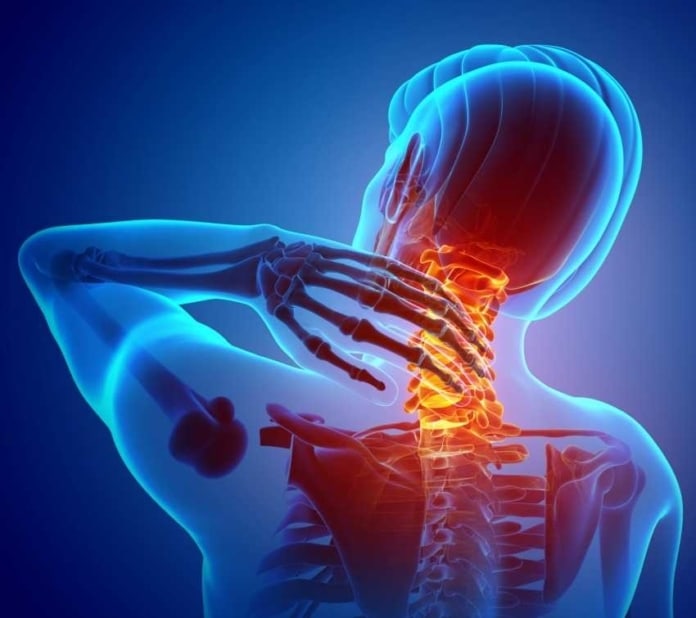Neck pain has been one of the most common medical issues I’ve seen in my clinics over the years, only second to low back pain. In the thousands of people I’ve treated, two factors almost always contribute to neck pain, no matter how abnormal the x-ray or MRI: (1) abnormal spinal alignment, and (2) poor muscle mechanics. Fortunately, these two issues can be managed easily with proper activity modification, stretching, and strengthening exercises.
How Abnormal Spinal Alignment and Poor Muscle Mechanics Contribute To Neck Pain
One of the key factors in managing your neck pain is learning how to keep your spine in a neutral position. A neutral spine begins with the position of your feet. When standing, your hips should be aligned with your ankles, shoulders aligned with your hips, and ears aligned with your shoulders (see the illustration below).
Your head should not be tilted backward or far forward (a slight forward tilt is fine). Your head/chin should not protrude forward. Your shoulders should be relaxed and not rounded in a slouching position or elevated in a tensed position.
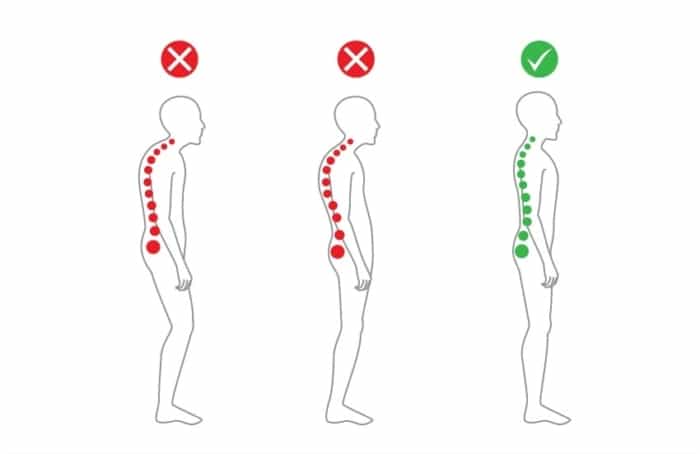
A neutral spinal alignment triggers contraction of the muscles that do not fatigue easily and rarely contribute to pain. If your spine is not in a proper alignment, the muscles that are activated are ones that fatigue easily, leading to muscle pain, cramps, soreness, stiffness, tightness, and even headaches.
Changing How You Do These 8 Activities Could Reduce or Even Eliminate Your Neck Pain
The activities you do every day can play a big part in your neck pain. Small changes to your spinal alignment (posture) and muscle mechanics could make a huge difference in your neck pain and quality of life.
1Sitting
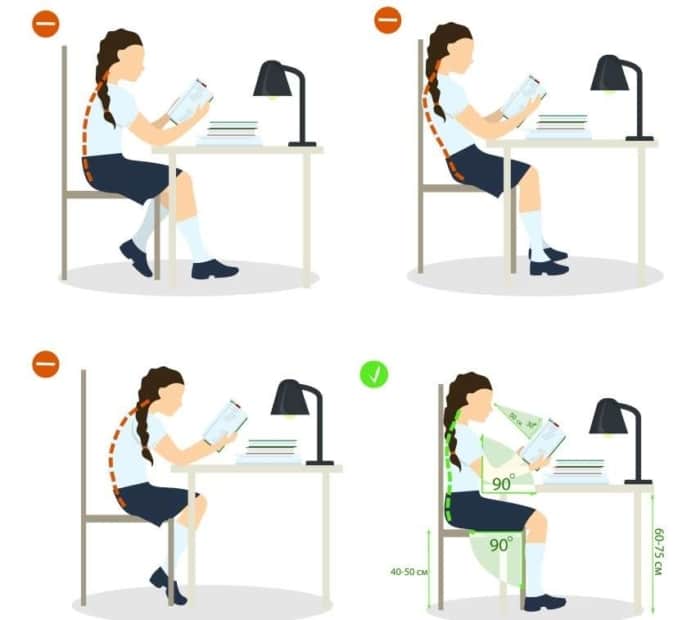
If your low back is not properly supported while sitting, your upper back tends to slouch which is a common cause of neck, shoulder, and upper back pain.
Solution
- Use a supportive chair that has lumbar and mid-back support (a lumbar cushion may be needed)
- Sit with your hips as far back on the chair as possible
- Keep your shoulders down, back, and relaxed (not slouched or tensed)
- If using a chair with a headrest, make sure it does not tilt your head forward or backward
- Center your chair so you avoid turning your head to the side for an extended period of time
2Watching TV
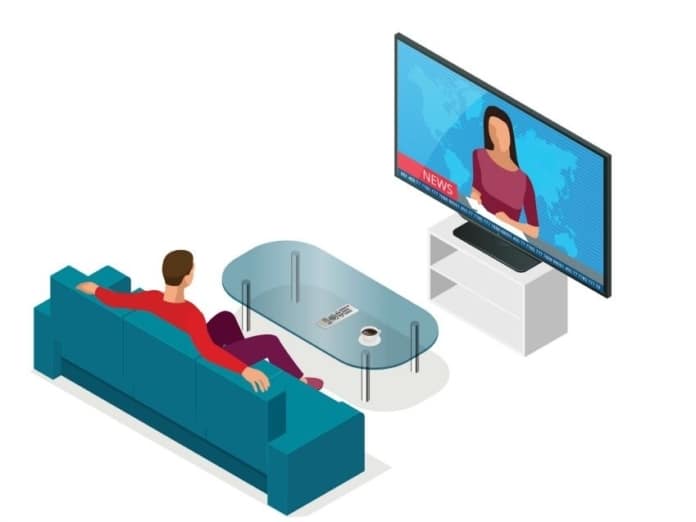
When your TV is placed above a fireplace or high on a wall, you usually have to tilt your head backward to view it.
When watching TV, you should be able to sit with your chin parallel to the floor or even tilted slightly downward. Your eyes should be able to comfortably view the entire TV in this position.
Solution
- Lower the position of your TV so you can view it easily without tilting your head backward
- Center the TV in front of your viewing area
- Sit with your hips as far back as possible on the couch/chair to avoid slouching
- Sit upright with the low back and mid-back supported (a lumbar cushion may be helpful)
- Keep your shoulders down, back, and relaxed (not slouched or tensed)
EXTRA TIP FOR THOSE WITH CHRONIC ILLNESS: It can be very tiring to sit for extended periods of time when you have a chronic illness. Sitting with pillows supporting your arms and a pillow supporting your head can help reduce fatigue.
3Using a Computer
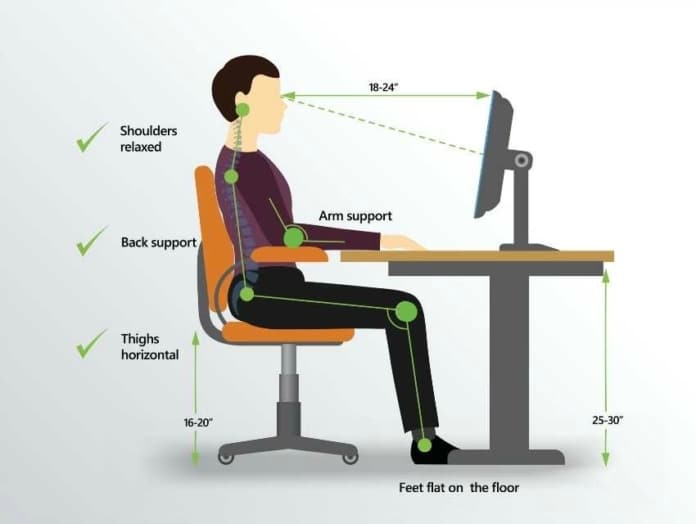
Your eyes are most comfortable when looking slightly downward at a computer screen. If your computer screen is positioned too high, your neck will tilt backward and can cause eye strain, neck pain, upper back pain, and shoulder pain.
If your shoulders are not supported in a relaxed position, your muscles will fatigue quickly which can trigger upper back, shoulder, and neck pain, as well as headaches.
Solution
Monitor Position
- Position the top of the monitor slightly below your line of eyesight (even lower if wearing bifocals)
- Keep your head in a neutral position with your chin parallel to the floor or slightly tilted downward
- Center the monitor in front of you, so your neck is not turned for an extended period of time
Keyboard and Mouse Position
- Adjust the keyboard height so that your shoulders are relaxed, your elbows are at an approximately 90-degree angle, and your wrists and hands are in line with the keyboard
- Keep the computer mouse as close to your body as possible so your shoulders stay relaxed (consider using an ergonomic keyboard which is tilted in the middle to allow a more natural position of your wrists)
Chair Position
- Use a supportive chair that has lumbar and mid-back support (a lumbar cushion may be needed)
- Sit with your hips as far back on the chair as possible
- Position your hips in line with or slightly higher than your knees
- If your feet do not touch the ground comfortably, consider using a footrest
- Keep your shoulders down, back, and relaxed (not slouched or tensed)
In addition to the above tips, if you are using a laptop, make these additional modifications:
- Use a laptop stand so the screen is properly placed slightly below eye level
- You may need to use a separate keyboard to keep your shoulders relaxed
4Sleeping
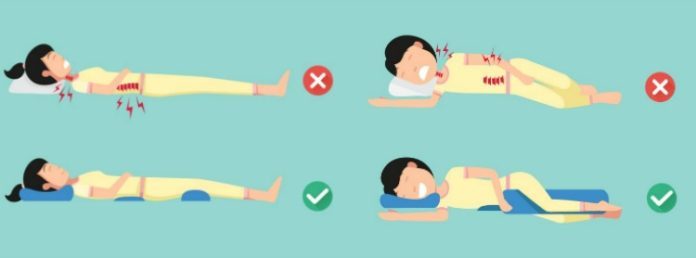
Neck pain is common if the spine is not in a neutral position while sleeping. Your neck/head should not tilt upward, downward, or to the side.
Solution
- Your mattress should support your entire spine and keep it in a neutral position (click here to learn more)
- Make sure your pillow completely fills the gap between your neck and the mattress to support your neck and keep it in a neutral position (click here to learn more)
- You may need additional cushions to keep your entire spine in a neutral position (see the illustration above)
- Avoid sleeping on your stomach because it flattens the natural curve of the spine and puts additional strain on your neck and back
Related Article: Practical Tips for Improving Your Sleep Tonight
5Talking on the Phone
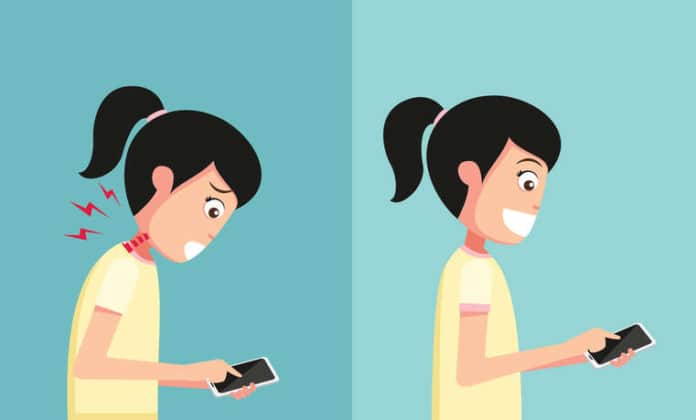
Most of us don’t realize how poor our posture is while using our phones, tablets, etc. Because we use these devices often, they are a common contributor to neck, shoulder, and upper back pain.
Solution
- Be mindful of your neck position
- Do not tilt your head to the side, backward, or too far forward
- Keep your shoulders down, back, and relaxed (not slouched or tensed)
- Consider a headset or other hands-free option if needed
EXTRA TIP FOR THOSE WITH CHRONIC ILLNESS: It can be easier to keep your spine neutral if you talk on the phone while lying down with a pillow supporting the arm holding the phone. This position also makes talking on the phone less tiring.
6Washing and Drying Your Hair

It is common for those of us with long hair to wrap our hair up into a towel to help it dry. If you use a regular bath towel, this is often too heavy for those with neck issues. Also, if you use a blow-dryer, you may have to tighten and elevate the shoulders to carry the weight of the dryer.
When squeezing the shampoo/conditioner bottle, if your hand is facing downward, there is a natural tendency for the elbow to lift away from the body and the shoulder to elevate which contributes to neck and shoulder pain. You can avoid this issue by squeezing these bottles with the palm facing upward.
Solution
- Use a lightweight hair towel to dry your hair
- Consider buying a lightweight blow dryer and be mindful of your arm position while using it
- When washing or blow-drying your hair, be mindful of how long you let your head stay in one particular position (any position for too long, other than neutral, can cause pain)
- When squeezing shampoo/conditioner bottles, make sure your palm is facing upward to prevent activation of the shoulder muscles
EXTRA TIP FOR THOSE WITH CHRONIC ILLNESS: Washing hair can be one of the hardest things to do for those with chronic illness. Using a shower chair can help reduce fatigue from this activity.
7Driving
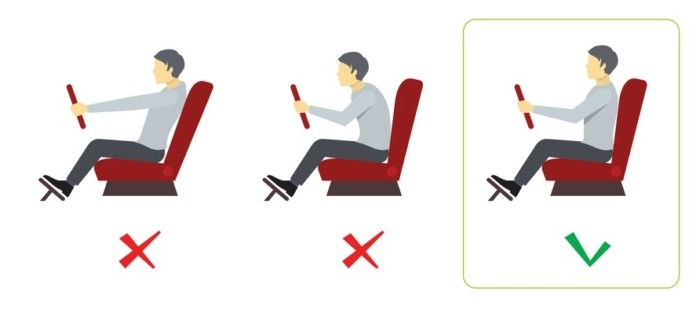
It is very common when driving to tighten and elevate the shoulders, especially if feeling stressed. This position causes significant strain on your neck and upper back muscles.
Solution
- Consider the use of a lumbar cushion to better support the spine
- Sit with your hips as far back on the car seat as possible
- Keep your shoulders down, back, and relaxed (not slouched or tensed)
8Carrying a Briefcase, Backpack, Packages, or Purse
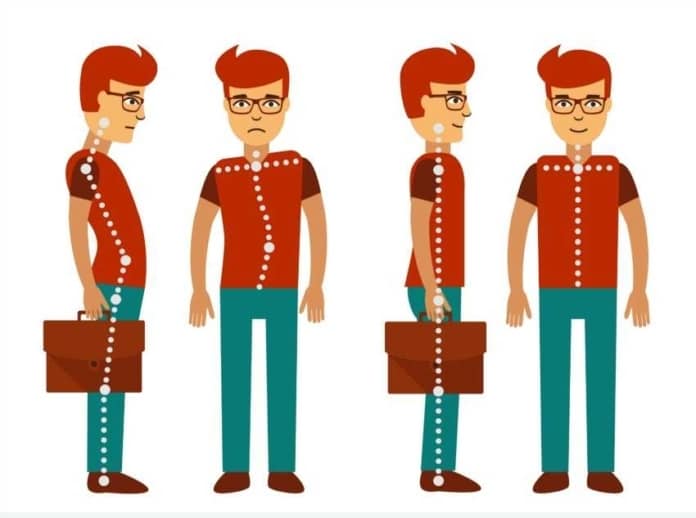
There is a natural tendency for the body to tilt towards the object being carried, especially if it is heavy. This puts stress on your spine and on the shoulder carrying the object.
Solution
- Try to keep your spine centered despite the uneven weight you are carrying
- Consider regularly switching the briefcase, package, or purse from side to side
- If carrying multiple packages, evenly disperse them between both of your hands
- If using a backpack, place both straps over both shoulders, instead of one strap over one shoulder
- Keep your shoulders down, back, and relaxed (not slouched or tensed)
Summary
You probably noticed three key recommendations repeated throughout this article. They are essential to understanding how to reduce your neck pain through using neutral spinal alignment and good muscle mechanics.
- The position of your low back and mid back affects the position of your upper back, shoulders, and neck.
- Be mindful of your spinal alignment. Keep your neck in line with the rest of your spine (neutral alignment), your ears in line with your shoulders, and your chin parallel to the floor or slightly tilted downward.
- Avoid slouching or tensing your shoulders by keeping them in a relaxed, down, and back position.
You can teach your body to make these changes automatically by being mindful of your body position and making the appropriate changes to reduce stress on the back, neck, and shoulders. In time, the proper muscles will get used to being activated, and maintaining these positions will get easier and easier.
[If you have difficulty making these changes on your own, consider working with a Physical Therapist who specializes in spine care.]
Interested in consulting Dr. Stenehjem? CLICK HERE to learn more.
© Copyright 2017 Mastering Health and Happiness, PLLC. All Rights Reserved.
